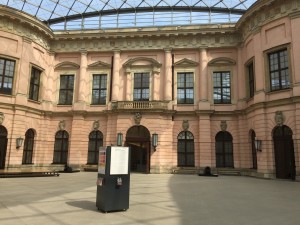Berlin was different than everywhere else we had been so far. There was graffiti everywhere, but it felt like art not vandalism. It gave the city character. Then there was the fact that remnants of the war were around every corner. We visited Checkpoint Charlie (only about a ten minute walk from our hotel), the site of Hitler’s Bunker, the Wannsee House where the Wannsee Conference took place, and the Berlin Wall. We were always standing on or in a bit of history.
The biggest difference from the other cities I noticed in Berlin was how the museums were set up. There was much more text than stuff in the exhibits. There was still the basic Nazi propaganda posters, the maps of the invasions, and even the Nazi propaganda film, Triumph of the Will, played on a loop. But instead of the museums being filled with all those objects, there was more text next to each thing explaining what it was and giving the background on how it was important in the war. They were just more informationally based than based on how much stuff they could fit in a glass case.

The Berlin Wall outside the Topography of Terror Museum. A faded painting of the American flag is shown here.
Furthermore, the most shocking part about the museums for me was that they were so honest. We visited the German Historical Museum on May 27th, and it was arguably my favorite museum we went to. I loved how objective the museum was. All it did was state the facts of the war. In no way did the museum try to manipulate us into having a certain emotional reaction, leave out any important information (like how almost every museum in France conveniently left out information on the collaborationist Vichy government), or even try to put some blame on another country. This museum simply stated the facts, and it stated everything. There was information about the Holocaust and even a replica structure of how the gas chambers operated in Auschwitz-Birkenau. I was really surprised by this considering it was the Nazi-German government that operated the Holocaust. I thought that a German museum would leave out any information about Holocaust, and it did the exact opposite. The German Historical Museum gave me the most information on the Holocaust out of all the museums we visited in Europe. There was information on the deportations, the systematic killings, and even on the Nazi propaganda movie to depict Jewish people as awful, greedy human beings called Jew Süss.

Site of one of the assassination attempts on Hitler. This is located in the German Historical Museum.
The most interesting part about the trip was seeing all the countries’ different perspectives on the war. By the time we arrived in Germany, I figured that every museum we would go to would have its own thoughts on the Second World War. I had no idea how a museum in Germany would take a nationalistic point of view for the war considering Germany was the home to the Nazi party that caused all the destruction in Europe, but I thought they would at least try. Fortunately, the German Historical Museum did none of that. It was refreshing to be in a museum that just stated all the facts and let me digest all the information and interpret it for myself. As another student stated on the trip, he would rather leave a museum with questions based on the content than leave the museum with questions because of lack of content. That was exactly how I felt leaving the German Historical Museum.
